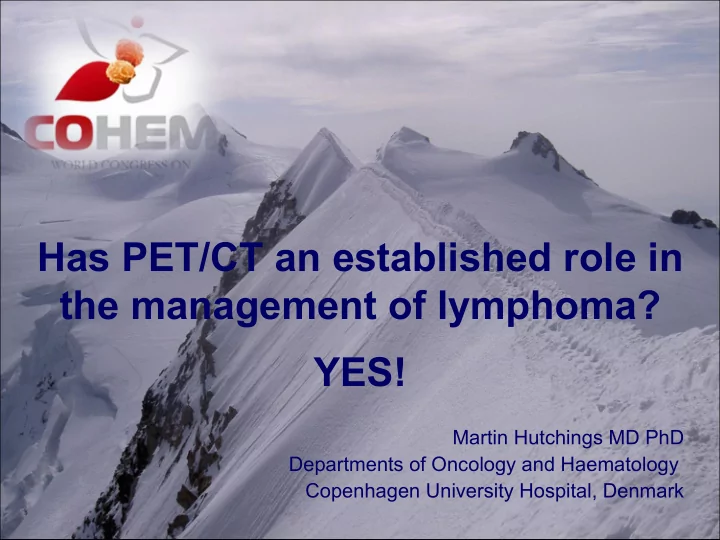

Has PET/CT an established role in the management of lymphoma? YES! Martin Hutchings MD PhD Departments of Oncology and Haematology Copenhagen University Hospital, Denmark
Cure rates vs. late effects Risk of overtreatment vs. risk of relapse Patient-tailored therapy
Ideal Real world Accurate pre-treatment Clinical staging prognostic and predictive Prognostic indices markers Response monitoring
PET/CT improves the accuracy of lymphoma staging Higher sensitivity than CT and other conventional staging methods, but not at the expense of the specificity 10-25% of patients are upstaged as a result of PET/CT, many to a more advanced treatment group Very few patients are downstaged
CT-based planning PET/CT-based planning PET/CT affects the delineation of modern radiotherapy fields in roughly ¼-⅓ of patients Hutchings et al. Eur J Haematol 2007 Girinsky et al. Radiother Oncol 2007
Is the improved staging accuracy of any benefit to the patients? - Probably, but only if accompanied by relevant and necessary changes in therapeutic strategy Examples: • IFRT to INRT • Respiratory gated PET/CT guided radiotherapy
Normal PET/CT Respiratory gated PET/CT Courtesy of Annika Loft
Jerusalem et al. Haematologica 2000 Hutchings et al. Ann Oncol 2005 Mikhaeel et al. Ann Oncol 2005 Hutchings et al. Blood 2006 PET for early treatment monitoring Gallamini et al. JCO 2007 Kostakoglu et al. J Nucl Med 2002 Response to initial treatment is the most powerful Response to initial treatment is the most powerful Gallamini et al. Haematologica 2006 prognostic indicator in lymphoma prognostic indicator in lymphoma Responders and non-responders can be precisely Responders and non-responders can be precisely identified by PET after a few chemotherapy cycles identified by PET after a few chemotherapy cycles Early interim PET is the best tool for risk-adapted Kostakoglu et al Cancer 2006. Spaepen et al. Ann Oncol 2002 Haioun et al. Blood 2005 lymphoma therapy
Post-treatment evaluation PET has very high NPV and variable PPV for post-treatment evaluation with conventional treatment New response criteria: If PET-negative = CR
Hodgkin lymphoma • 60 pts., all stages • Treated with Stanford Time to next treatment (years) Time to next treatment (years) V or MOPP/ABVD • Additional radiotherapy in most patients Overall survival (years) Overall survival (years) Brepoels et al. Leuk Lymphoma 2007;48:1539–47
Aggressive NHL Brepoels et al. Leuk Lymphoma 2007;48:1522–30
PET in the follow-up setting Has only been investigated in few studies e.g. Jerusalem et al. Ann Oncol 2003, Zinzani et al. Haematologica 2007 PET identifies some relapsing patients before CT and prior to clinical symptoms Large number of false positive results Benefit for relapsing patients is unclear
Other tracers than FDG Nucleoside analogues - target cell proliferation Amino acid tracers - reflecting protein synthesis Tracers directly targeting apoptosis Tracers targeting more disease-specific cell surface molecules
Does PET/CT have a role in lymphoma? • Staging : Yes: 1) Better basis for risk stratified treatment, and 2) more refined definition of radiotherapy volumes – less irradiation to normal tissues • Early treatment monitoring: –Yes: Early PET/CT may help tailor therapy to the individual patient and thus improve outcomes while still reduce unnecessary over-treatment • Posttreatment evaluation: –Yes: PET/CT is the cornerstone of the revised response criteria and seems prognostically stronger than the old ones • Radiotherapy planning: –Yes: PET/CT is needed to further refine radiotherapy volumes and help reduce irradiation to normal tissues • Follow-up: –No. The value remains to be proven (as does the value of CT)
Works ahead Common reading criteria for interim PET and for post-treatment PET PET in monitoring radioimmunotherapy and biological agents Enrol our patients into PET-driven clinical trials
Recommend
More recommend